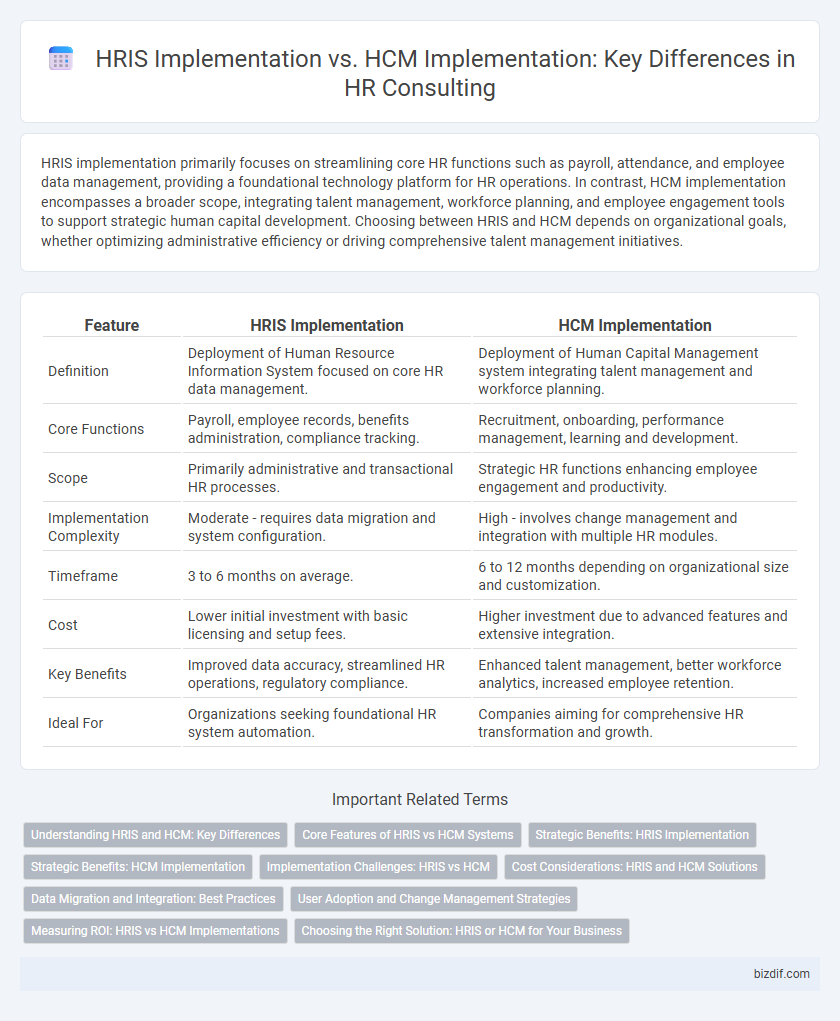HRIS implementation primarily focuses on streamlining core HR functions such as payroll, attendance, and employee data management, providing a foundational technology platform for HR operations. In contrast, HCM implementation encompasses a broader scope, integrating talent management, workforce planning, and employee engagement tools to support strategic human capital development. Choosing between HRIS and HCM depends on organizational goals, whether optimizing administrative efficiency or driving comprehensive talent management initiatives.
Table of Comparison
| Feature | HRIS Implementation | HCM Implementation |
|---|---|---|
| Definition | Deployment of Human Resource Information System focused on core HR data management. | Deployment of Human Capital Management system integrating talent management and workforce planning. |
| Core Functions | Payroll, employee records, benefits administration, compliance tracking. | Recruitment, onboarding, performance management, learning and development. |
| Scope | Primarily administrative and transactional HR processes. | Strategic HR functions enhancing employee engagement and productivity. |
| Implementation Complexity | Moderate - requires data migration and system configuration. | High - involves change management and integration with multiple HR modules. |
| Timeframe | 3 to 6 months on average. | 6 to 12 months depending on organizational size and customization. |
| Cost | Lower initial investment with basic licensing and setup fees. | Higher investment due to advanced features and extensive integration. |
| Key Benefits | Improved data accuracy, streamlined HR operations, regulatory compliance. | Enhanced talent management, better workforce analytics, increased employee retention. |
| Ideal For | Organizations seeking foundational HR system automation. | Companies aiming for comprehensive HR transformation and growth. |
Understanding HRIS and HCM: Key Differences
HRIS (Human Resource Information System) primarily focuses on managing employee data, payroll, and administrative HR tasks through centralized software, streamlining core HR processes. HCM (Human Capital Management) expands beyond HRIS by incorporating talent management, employee performance, learning and development, and strategic workforce planning to align HR operations with business goals. Understanding these distinctions helps organizations choose the right system based on whether their priority is operational efficiency (HRIS) or comprehensive workforce optimization (HCM).
Core Features of HRIS vs HCM Systems
HRIS (Human Resource Information System) primarily focuses on core features such as employee data management, payroll processing, attendance tracking, and compliance reporting. HCM (Human Capital Management) systems encompass all HRIS functionalities and extend to talent management, recruitment, learning and development, and performance management. Organizations aiming for comprehensive workforce management benefit from HCM's integrated modules, whereas HRIS suits companies needing streamlined administrative HR processes.
Strategic Benefits: HRIS Implementation
HRIS implementation centralizes employee data management, enhancing data accuracy and streamlining HR processes for improved decision-making. It supports compliance and risk management by providing reliable audit trails and real-time reporting capabilities. This foundation enables HR teams to focus on strategic initiatives, driving organizational efficiency and workforce productivity.
Strategic Benefits: HCM Implementation
HCM implementation delivers strategic benefits by integrating core HR functions with talent management, workforce planning, and employee engagement tools, driving improved decision-making and organizational agility. It enhances data accuracy and real-time analytics, enabling HR leaders to optimize workforce performance and align human capital strategies with business goals. Unlike standalone HRIS, HCM systems support a comprehensive approach to talent development and succession planning, fostering long-term growth and competitive advantage.
Implementation Challenges: HRIS vs HCM
HRIS implementation challenges often revolve around data integration complexities, system customization limits, and ensuring user adoption within existing workflows. HCM implementation faces additional hurdles including aligning talent management modules, advanced analytics integration, and accommodating comprehensive workforce planning needs. Both require meticulous change management and stakeholder engagement to minimize disruption and maximize system effectiveness.
Cost Considerations: HRIS and HCM Solutions
HRIS implementation typically involves lower upfront costs as it focuses on core functions like payroll and employee data management, making it suitable for small to mid-sized businesses. HCM solutions, however, demand higher investment due to their comprehensive capabilities, including talent management, workforce planning, and employee engagement tools. Cost considerations should include licensing fees, customization expenses, integration complexity, and ongoing support to determine the best fit for organizational needs and budget constraints.
Data Migration and Integration: Best Practices
Data migration during HRIS implementation requires meticulous validation to ensure employee records, payroll, and benefits data transfer accurately without loss or corruption. HCM implementation involves more complex integration with talent management, learning, and performance systems, necessitating real-time data synchronization and API-based connectivity. Best practices include comprehensive pre-migration audits, staged testing environments, and ongoing monitoring to maintain data integrity and optimize system interoperability.
User Adoption and Change Management Strategies
Effective HRIS implementation requires targeted change management strategies to enhance user adoption by simplifying system interfaces and providing comprehensive training tailored to different user roles. HCM implementation demands a more holistic approach, integrating advanced analytics and workforce planning tools while fostering cultural shifts through continuous communication and leadership alignment. Prioritizing stakeholder engagement and iterative feedback loops accelerates adoption rates and ensures sustainable organizational transformation.
Measuring ROI: HRIS vs HCM Implementations
Measuring ROI of HRIS implementation centers on cost savings through automated payroll, time tracking, and basic employee data management, delivering quick operational efficiencies. HCM implementation ROI includes these benefits plus advanced talent management, workforce planning, and employee development, driving long-term strategic value and improved employee engagement. Organizations focused on scalability and strategic growth typically realize higher ROI from HCM solutions compared to traditional HRIS systems.
Choosing the Right Solution: HRIS or HCM for Your Business
Choosing between HRIS and HCM systems depends on your business needs for workforce management and strategic growth. HRIS focuses on core functions like payroll, benefits administration, and employee data management, while HCM integrates talent management, performance analytics, and employee development for a comprehensive approach. Evaluating your company's size, complexity, and long-term HR goals ensures selecting the right solution that enhances operational efficiency and supports organizational transformation.
HRIS Implementation vs HCM Implementation Infographic

 bizdif.com
bizdif.com